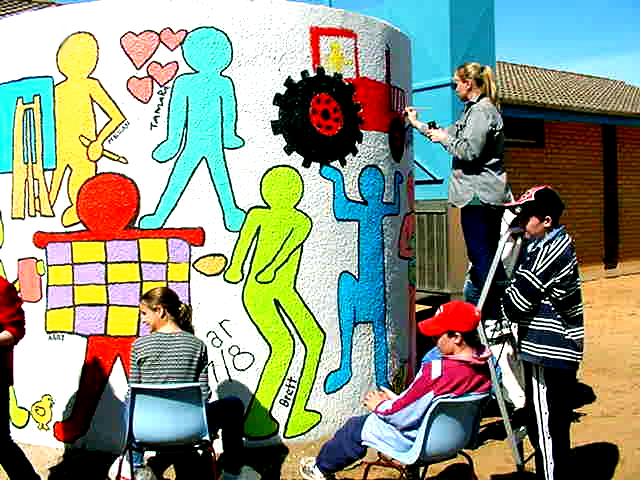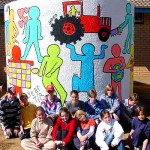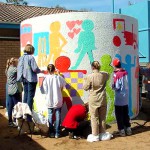
Categories
- Curriculum: Art | Dance & Music
- Age/Grade: Middle School | Above 14
- Subject: Drawing | Painting | Exhibition
- Materials: Pencils | Paint
- Institution: Quandialla Central School
- Location: New South Wales, Australia
- Duration: 9 or More Classes
Description
This middle school in Australia used Keith Haring's dancing figures as inspiration for a mural on a water tank using characters that represent their school subjects.
Objective
To introduce students to the art and life of artist Keith Haring.
To explore drawing on a large scale.
To identify the use of symbols in artworks.
To understand that one's immediate environment can provide inspiration for artworks.
To emphasize teamwork and cooperation.
Resources
Visual Aids - colour reproductions of Haring's murals depicting moving figures
HaringKids web site
Materials
Sketchbooks
Water based outdoor paint for painting on exterior surfaces (approximately 8 to 10 different bright colours in 500 ml tubs/tins
Primer (protective coating under paint)
Shellac or polyurethane (protective coating over paint)
Old containers for paint
Paint shirts
Large brushes
Step ladder for teachers to reach higher spots.
Procedure
INTRODUCTION
This lesson was designed for a Grade 7 & 8 Visual Arts class at Quandialla Central School, New south Wales, Australia. The lesson was introduced with some art history / appreciation by looking at the work of Keith Haring and his murals.
STEP 1
The students did many drawings in the Haring's style and were eventually asked to choose a subject they studied at Quandialla Central School. We covered Maths, English, Science, History, Agriculture, Visual arts, physical education, and many more. Each students designed a figure for a different subject. Symbols that stood for each subject were explored so that anyone viewing the mural could understand what each figure represented.
STEP 2
When final drawings were complete, the outlines of each figure were drawn onto a primed water tank in desperate need of a facelift. They kept in mind that their figures had to be scaled up to suit the height of the water tank.
STEP 3
Students then painted in their chosen figures and then outlined them in black paint, signing their name with their figure.
The entire project was completed in approximately 10 lessons of 40 minutes (A double period per week for 5 weeks) but can be extended as needed. The actual tank painting took 2 double periods.It was a great success and the students can see their work from the art room window!
Questions
How is Keith Haring able to convey ideas with such simple figures that have no facial features, etc.?
What other types of people, occupations, emotions etc, can be represented through various symbols attached to a simple human figure?
How did it feel to see your drawings so large, the size of your own body?
How do you think other people might feel seeing the water tank from afar and from up close? Does the impression change from different perspectives?
What's so interesting about public art? How does it differ from art made for a museum or gallery? How do the audiences differ?
How can art be a collaborative process? How did working with others further your concepts and approach?
Extensions
Make a little documentary about the production and responses to the water tank. Film the students working on it from beginning to end. Have students come up with interview questions for their peers in response to their work. Cover their process, their technique, their intentions, the emotional response during their process and with their finished piece, their aspirations for the work and for other people's response to it... Then have students interview teachers and other kids in the school, not affiliated with the project. Ask them their thoughts about the new water tank. Have the students go out into the streets and ask people in the neighborhood, who see the water tank from where they live and work, what they think. Students can then edit the film.





